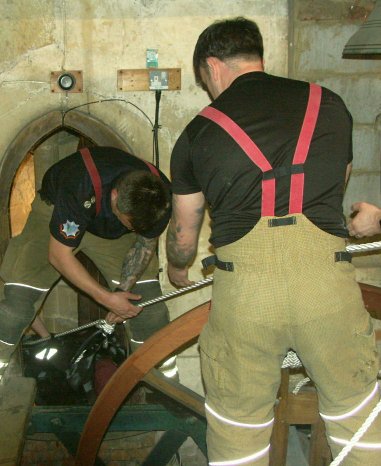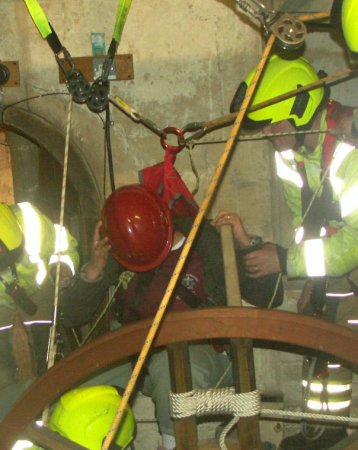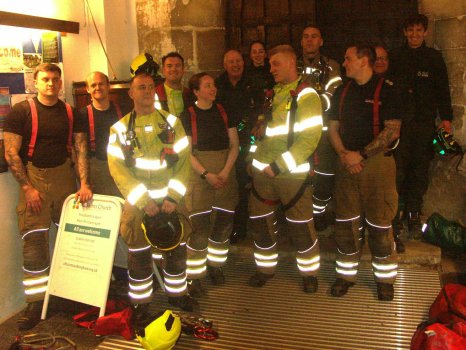One thing leads to another
At All Saints Wokingham we are always happy to share the experience of ringing and bells with the wider community – we give talks, run open days show group round the tower. So when a team from the local fire service asked to visit the tower last year we were happy to oblige.
They arrived by fire engine, despite the church being a few minutes walk from the fire station, because they were on duty and might be called out to an emergency while they were in the tower.
We explained how ringing works and how bells are hung, we demonstrated ringing a bell, we showed them the historic clock and let them experience the stunning views from the tower roof. As with all our visitors they were fascinating, but their visit was more than just a jolly. To ensure they are prepared for anything that might happen they need to understand the special needs of any unusual buildings in their area. They recognised the tower as a special place and were keen to understand how it is used, how the different spaces are accessed, what was in them, and how we would know if there was a fire in the church.
One question I wasn’t expecting was about what valuables to rescue. I didn’t realise that as well as deploying a team to tackle the blaze they would also try to retrieve whatever it would be most important to save from the building. Of course, the most valuable things in the tower are the bells, which aren’t removable, but we have several historic pealboards that we spent nearly £1000 to restore in 2017.
The name ‘Fire and Rescue Service’ is a clue that they get called out to a lot more than fires, and rescuing people trapped in hazardous situations forms a large part of their work. When they saw the bell chamber they realised that rescuing someone injured in it would be challenging, so in March they returned for a rescue exercise, along with colleagues from Bracknell and from South Central Ambulance Service Hazardous Area Response Team,
 The exercise involved two ‘casualties’ in the pits under the bells, and the aim was to remove them safely. One casualty was an 80kg dummy and the other was the Wokingham Fire Service Chaplain who, unlike the dummy, was able to complain when the lifting harness dug into her neck and when the head protection they gave her pushed down over her face so she couldn't see.
The exercise involved two ‘casualties’ in the pits under the bells, and the aim was to remove them safely. One casualty was an 80kg dummy and the other was the Wokingham Fire Service Chaplain who, unlike the dummy, was able to complain when the lifting harness dug into her neck and when the head protection they gave her pushed down over her face so she couldn't see.
The teams’ first challenge was to work out how to get the casualties out of a pit without making their injuries worse – one had a spinal/neck injury and in the other had a severe leg fracture – there weren't many options. The team also had to bear in mind their own safety. Most of them had never even seen a bell chamber let alone worked in one so it was an alien environment for them. An incautious move while focused on their tasks, or just moving around the frame, could have led to a serious fall.
The teams carry packs of equipment that they might need, including ropes, harnesses, and lifting gear. They were lucky that there are beams strong enough to support lifting gear above the pits where the casualties were,
 The first casualty was fitted with a lifting harness – not easy when she was in a bell pit with an injured leg. The ropes from her harness went over pulleys slung from the beam, with rescuers in other pits pulling the ropes to lift her. Getting her high enough to move over the adjacent bell was difficult, but they managed it with a bit of help from her good leg. Once at the door she was able to 'bum shuffle' down the narrow spiral stair with her weight carried by the rope from above, a rescuer below to support her injured leg and another behind to guide her.
The first casualty was fitted with a lifting harness – not easy when she was in a bell pit with an injured leg. The ropes from her harness went over pulleys slung from the beam, with rescuers in other pits pulling the ropes to lift her. Getting her high enough to move over the adjacent bell was difficult, but they managed it with a bit of help from her good leg. Once at the door she was able to 'bum shuffle' down the narrow spiral stair with her weight carried by the rope from above, a rescuer below to support her injured leg and another behind to guide her.
The second casualty needed to be kept straight, which made getting it out of the pit more difficult, especially since it was a dummy that couldn't cooperate. The ambulance team had a special stretcher, like a sheet of stiff plastic that could be rolled around the casualty into a stiff tube to provide support. But the pit was too narrow to open it, let alone get the dummy onto it. So they had to use a different stretcher (the one the dummy came up on). It didn't wrap round him so they had to lash the him securely.
The stretcher came out of the pit OK, lifted by a rope on one end going over a pulley, but then it met a problem. To fit through the narrow door the stretcher had to be turned head on to it, but there was a wheel in the way, and they had to lift it even higher to get over that. Once through the door the stretcher was lowered down stairs, guided by rescuers and with its weight carried by the rope above.
 The exercise took 2½ hours and didn’t end until nearly 11pm so they were all keen to pack up. As a civilian observer I found it interesting to watch the exercise. There were a lot of people working in a very confined and slightly hazardous space. They were all trained but they hadn't all worked together before. They were under pressure and had a difficult problem to solve – rescuing two seriously injured people (albeit not real injuries this time). The Watch Leader who organised the exercise was delighted that the teams were able to train in the tower since they don’t often get the chance to access such environments.
The exercise took 2½ hours and didn’t end until nearly 11pm so they were all keen to pack up. As a civilian observer I found it interesting to watch the exercise. There were a lot of people working in a very confined and slightly hazardous space. They were all trained but they hadn't all worked together before. They were under pressure and had a difficult problem to solve – rescuing two seriously injured people (albeit not real injuries this time). The Watch Leader who organised the exercise was delighted that the teams were able to train in the tower since they don’t often get the chance to access such environments.
One thing I didn’t expect – while chatting to the ‘casualty’ before the exercise she let slip that she rang in her youth. I suggested she should take it up again, after all being on the end of a bellrope is more fun than sitting in a pit waiting to be rescued, but I don’t know whether I convinced her.
The initial request for a visit came out of the blue. The watch leader had recognised that they didn't know much about the tower and he wanted to find out more. He got no reply from the Rector (which is unlike her but she had just taken over a very busy parish including moving house, and was one down with an assistant priest vacancy). Fortunately someone in the community knew that we had an active band of ringers and suggested he contact us direct, so he went online, found the tower website, got my contact details and the rest is history.
We didn’t initiate the visit but it was good community outreach, and it could well lead to more contacts as word gets round (there’s also a write up on the Fire Service Facebook page). I know several towers have done similar things, but if it hasn’t in your area, why not make the offer.
John Harrison
Originally published in The Ringing World on 25 April 2025.
The full story with more pictures is on the tower website at: allsaintswokinghambells.org.uk/ASTower/Rescue/ .
 The exercise involved two ‘casualties’ in the pits under the bells, and the aim was to remove them safely. One casualty was an 80kg dummy and the other was the Wokingham Fire Service Chaplain who, unlike the dummy, was able to complain when the lifting harness dug into her neck and when the head protection they gave her pushed down over her face so she couldn't see.
The exercise involved two ‘casualties’ in the pits under the bells, and the aim was to remove them safely. One casualty was an 80kg dummy and the other was the Wokingham Fire Service Chaplain who, unlike the dummy, was able to complain when the lifting harness dug into her neck and when the head protection they gave her pushed down over her face so she couldn't see.  The first casualty was fitted with a lifting harness – not easy when she was in a bell pit with an injured leg. The ropes from her harness went over pulleys slung from the beam, with rescuers in other pits pulling the ropes to lift her. Getting her high enough to move over the adjacent bell was difficult, but they managed it with a bit of help from her good leg. Once at the door she was able to 'bum shuffle' down the narrow spiral stair with her weight carried by the rope from above, a rescuer below to support her injured leg and another behind to guide her.
The first casualty was fitted with a lifting harness – not easy when she was in a bell pit with an injured leg. The ropes from her harness went over pulleys slung from the beam, with rescuers in other pits pulling the ropes to lift her. Getting her high enough to move over the adjacent bell was difficult, but they managed it with a bit of help from her good leg. Once at the door she was able to 'bum shuffle' down the narrow spiral stair with her weight carried by the rope from above, a rescuer below to support her injured leg and another behind to guide her.  The exercise took 2½ hours and didn’t end until nearly 11pm so they were all keen to pack up. As a civilian observer I found it interesting to watch the exercise. There were a lot of people working in a very confined and slightly hazardous space. They were all trained but they hadn't all worked together before. They were under pressure and had a difficult problem to solve – rescuing two seriously injured people (albeit not real injuries this time). The Watch Leader who organised the exercise was delighted that the teams were able to train in the tower since they don’t often get the chance to access such environments.
The exercise took 2½ hours and didn’t end until nearly 11pm so they were all keen to pack up. As a civilian observer I found it interesting to watch the exercise. There were a lot of people working in a very confined and slightly hazardous space. They were all trained but they hadn't all worked together before. They were under pressure and had a difficult problem to solve – rescuing two seriously injured people (albeit not real injuries this time). The Watch Leader who organised the exercise was delighted that the teams were able to train in the tower since they don’t often get the chance to access such environments.